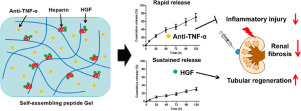当前位置:
X-MOL 学术
›
Acta Biomater.
›
论文详情
Our official English website, www.x-mol.net, welcomes your
feedback! (Note: you will need to create a separate account there.)
A self-assembling peptide hydrogel-based drug co-delivery platform to improve tissue repair after ischemia-reperfusion injury.
Acta Biomaterialia ( IF 9.4 ) Pub Date : 2019-12-13 , DOI: 10.1016/j.actbio.2019.12.011 Shuyun Liu 1 , Meng Zhao 1 , Yijie Zhou 1 , Ling Li 2 , Chengshi Wang 1 , Yujia Yuan 1 , Lan Li 1 , Guangneng Liao 3 , William Bresette 4 , Younan Chen 1 , Jingqiu Cheng 1 , Yanrong Lu 1 , Jingping Liu 1
Acta Biomaterialia ( IF 9.4 ) Pub Date : 2019-12-13 , DOI: 10.1016/j.actbio.2019.12.011 Shuyun Liu 1 , Meng Zhao 1 , Yijie Zhou 1 , Ling Li 2 , Chengshi Wang 1 , Yujia Yuan 1 , Lan Li 1 , Guangneng Liao 3 , William Bresette 4 , Younan Chen 1 , Jingqiu Cheng 1 , Yanrong Lu 1 , Jingping Liu 1
Affiliation

|
Ischemia-reperfusion (I/R)-induced organ injury is a serious health problem worldwide, and poor recovery of acute phase injury leads to chronic fibrosis and further organ dysfunction. Thus, a more precise approach to enhance tissue repair is needed. By using a renal I/R model, we aimed to evaluate the role of a hydrogel-based dual-drug delivery platform on promoting tissue repair. An injectable, self-assembling peptide/heparin (SAP/Hep) hydrogel was used to co-deliver TNF-α neutralizing antibody (anti-TNF-α) and hepatocyte growth factor (HGF). The microstructure and controlled release properties of KLD2R/Hep hydrogel were analyzed. The effects of the drug-loaded hydrogel (SAP-drug) on renal injury were evaluated in mice with I/R injury. In vitro, the SAP/Hep hydrogel allowed for a faster release of anti-TNF-α with a sustained release of HGF, and both drugs maintained their bioactivities after release. In vivo, combined anti-TNF-α/HGF showed better renal protective potential than anti-TNF-α or HGF alone. SAP-drug (anti-TNF-α/HGF in SAP hydrogel) treatment reduced the level of serum creatinine (Scr), blood urea nitrogen (BUN), tubular apoptosis, renal inflammatory factors, and macrophage infiltration compared to Free-drug (anti-TNF-α/HGF in solution) or SAP alone. Moreover, the SAP-drug group had better efficacy on promoting tubular cell proliferation and dedifferentiation than SAP or Free-drug alone, and thus reduced chronic renal fibrosis in I/R mice. This study highlighted that SAP could sequentially deliver the two drugs to achieve anti-inflammatory and pro-proliferative effects with one injection and thus is a promising delivery platform for tissue repair. STATEMENT OF SIGNIFICANCE: Ischemia-reperfusion (I/R)-induced organ injury is a serious health issue, and delayed tissue repair leads to chronic fibrosis and organ failure. Systemic administration of anti-inflammatory agents or growth factors have shown some benefits on I/R injury, but their therapeutic efficacy was limited by side effects, poor bioavailability, and absent key signals of tissue repair. To address these issues, a hydrogel-based drug co-delivery platform was used to treat I/R injury. This platform could achieve sequential release kinetics with faster rate of anti-TNF-ɑ and slower rate of HGF, and effectively promoted tissue repair by targeting inflammation and proliferation in mice with renal I/R. This nanoscale delivery platform represents a promising strategy for solid organs (heart, liver and kidney) regeneration after I/R.
中文翻译:

自组装肽基于水凝胶的药物共同递送平台,可改善缺血再灌注损伤后的组织修复。
缺血再灌注(I / R)引起的器官损伤是全球范围内的严重健康问题,急性期损伤的恢复不良会导致慢性纤维化和进一步的器官功能障碍。因此,需要一种更精确的方法来增强组织修复。通过使用肾脏I / R模型,我们旨在评估基于水凝胶的双重药物递送平台在促进组织修复中的作用。使用可注射的自组装肽/肝素(SAP / Hep)水凝胶共同递送TNF-α中和抗体(anti-TNF-α)和肝细胞生长因子(HGF)。分析了KLD2R / Hep水凝胶的微观结构和控释性能。在患有I / R损伤的小鼠中评估了载药水凝胶(SAP-药物)对肾损伤的影响。在体外,SAP / Hep水凝胶可实现抗TNF-α的更快释放和HGF的持续释放,两种药物在释放后均保持其生物活性。在体内,联合使用的抗TNF-α/ HGF比单独使用抗TNF-α或HGF表现出更好的肾脏保护潜力。与游离药物(抗)相比,SAP药物(SAP水凝胶中的抗TNF-α/ HGF)治疗可降低血清肌酐(Scr),血尿素氮(BUN),肾小管凋亡,肾炎因子和巨噬细胞浸润的水平。 -TNF-α/ HGF(溶液中)或单独使用SAP。此外,SAP药物组比单独使用SAP或Free药物具有更好的促进肾小管细胞增殖和去分化的功效,从而减少了I / R小鼠的慢性肾纤维化。这项研究强调,SAP可以一次注射两种药物,从而达到抗炎和促增殖的作用,因此是有希望的组织修复递送平台。意义声明:缺血再灌注(I / R)诱导的器官损伤是一个严重的健康问题,延迟的组织修复会导致慢性纤维化和器官衰竭。全身施用抗炎药或生长因子已显示出对I / R损伤的某些益处,但它们的治疗效果受到副作用,生物利用度差和缺乏组织修复关键信号的限制。为了解决这些问题,使用了基于水凝胶的药物共同递送平台来治疗I / R损伤。该平台可实现顺序释放动力学,具有更快的抗TNF-α率和更低的HGF率,并通过靶向肾I / R小鼠的炎症和增殖来有效地促进组织修复。该纳米级递送平台代表了I / R后实体器官(心脏,肝脏和肾脏)再生的有前途的策略。缺血再灌注(I / R)引起的器官损伤是一个严重的健康问题,延迟的组织修复会导致慢性纤维化和器官衰竭。全身施用抗炎药或生长因子已显示出对I / R损伤的某些益处,但它们的治疗效果受到副作用,生物利用度差和缺乏组织修复关键信号的限制。为了解决这些问题,使用了基于水凝胶的药物共同递送平台来治疗I / R损伤。该平台可实现顺序释放动力学,具有更快的抗TNF-α率和更低的HGF率,并通过靶向肾I / R小鼠的炎症和增殖来有效促进组织修复。该纳米级递送平台代表了I / R后实体器官(心脏,肝脏和肾脏)再生的有前途的策略。缺血再灌注(I / R)引起的器官损伤是一个严重的健康问题,延迟的组织修复会导致慢性纤维化和器官衰竭。全身施用抗炎药或生长因子已显示出对I / R损伤的某些益处,但它们的治疗效果受到副作用,生物利用度差和缺乏组织修复关键信号的限制。为了解决这些问题,使用了基于水凝胶的药物共同递送平台来治疗I / R损伤。该平台可实现顺序释放动力学,具有更快的抗TNF-α率和更低的HGF率,并通过靶向肾I / R小鼠的炎症和增殖来有效促进组织修复。该纳米级递送平台代表了I / R后实体器官(心脏,肝脏和肾脏)再生的有前途的策略。
更新日期:2019-12-13
中文翻译:

自组装肽基于水凝胶的药物共同递送平台,可改善缺血再灌注损伤后的组织修复。
缺血再灌注(I / R)引起的器官损伤是全球范围内的严重健康问题,急性期损伤的恢复不良会导致慢性纤维化和进一步的器官功能障碍。因此,需要一种更精确的方法来增强组织修复。通过使用肾脏I / R模型,我们旨在评估基于水凝胶的双重药物递送平台在促进组织修复中的作用。使用可注射的自组装肽/肝素(SAP / Hep)水凝胶共同递送TNF-α中和抗体(anti-TNF-α)和肝细胞生长因子(HGF)。分析了KLD2R / Hep水凝胶的微观结构和控释性能。在患有I / R损伤的小鼠中评估了载药水凝胶(SAP-药物)对肾损伤的影响。在体外,SAP / Hep水凝胶可实现抗TNF-α的更快释放和HGF的持续释放,两种药物在释放后均保持其生物活性。在体内,联合使用的抗TNF-α/ HGF比单独使用抗TNF-α或HGF表现出更好的肾脏保护潜力。与游离药物(抗)相比,SAP药物(SAP水凝胶中的抗TNF-α/ HGF)治疗可降低血清肌酐(Scr),血尿素氮(BUN),肾小管凋亡,肾炎因子和巨噬细胞浸润的水平。 -TNF-α/ HGF(溶液中)或单独使用SAP。此外,SAP药物组比单独使用SAP或Free药物具有更好的促进肾小管细胞增殖和去分化的功效,从而减少了I / R小鼠的慢性肾纤维化。这项研究强调,SAP可以一次注射两种药物,从而达到抗炎和促增殖的作用,因此是有希望的组织修复递送平台。意义声明:缺血再灌注(I / R)诱导的器官损伤是一个严重的健康问题,延迟的组织修复会导致慢性纤维化和器官衰竭。全身施用抗炎药或生长因子已显示出对I / R损伤的某些益处,但它们的治疗效果受到副作用,生物利用度差和缺乏组织修复关键信号的限制。为了解决这些问题,使用了基于水凝胶的药物共同递送平台来治疗I / R损伤。该平台可实现顺序释放动力学,具有更快的抗TNF-α率和更低的HGF率,并通过靶向肾I / R小鼠的炎症和增殖来有效地促进组织修复。该纳米级递送平台代表了I / R后实体器官(心脏,肝脏和肾脏)再生的有前途的策略。缺血再灌注(I / R)引起的器官损伤是一个严重的健康问题,延迟的组织修复会导致慢性纤维化和器官衰竭。全身施用抗炎药或生长因子已显示出对I / R损伤的某些益处,但它们的治疗效果受到副作用,生物利用度差和缺乏组织修复关键信号的限制。为了解决这些问题,使用了基于水凝胶的药物共同递送平台来治疗I / R损伤。该平台可实现顺序释放动力学,具有更快的抗TNF-α率和更低的HGF率,并通过靶向肾I / R小鼠的炎症和增殖来有效促进组织修复。该纳米级递送平台代表了I / R后实体器官(心脏,肝脏和肾脏)再生的有前途的策略。缺血再灌注(I / R)引起的器官损伤是一个严重的健康问题,延迟的组织修复会导致慢性纤维化和器官衰竭。全身施用抗炎药或生长因子已显示出对I / R损伤的某些益处,但它们的治疗效果受到副作用,生物利用度差和缺乏组织修复关键信号的限制。为了解决这些问题,使用了基于水凝胶的药物共同递送平台来治疗I / R损伤。该平台可实现顺序释放动力学,具有更快的抗TNF-α率和更低的HGF率,并通过靶向肾I / R小鼠的炎症和增殖来有效促进组织修复。该纳米级递送平台代表了I / R后实体器官(心脏,肝脏和肾脏)再生的有前途的策略。











































 京公网安备 11010802027423号
京公网安备 11010802027423号